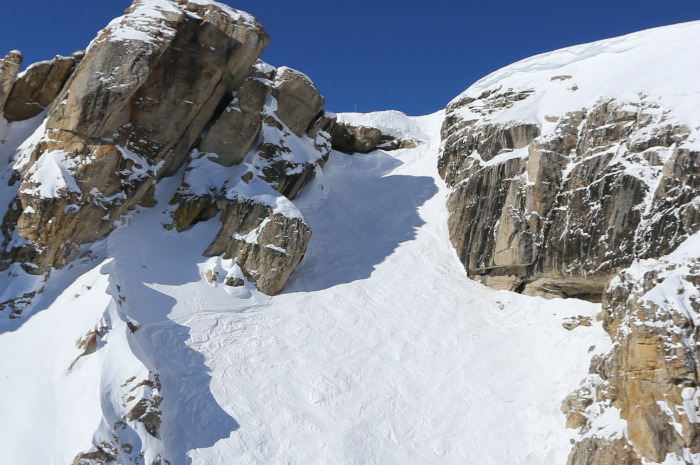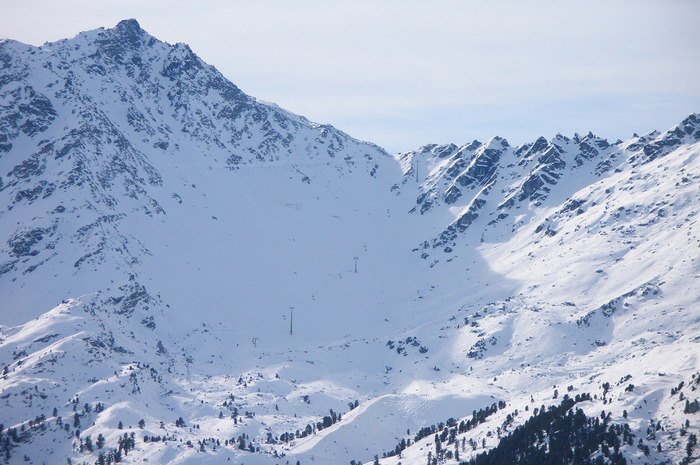The 15 Most Dangerous Ski Runs In The World
The Most Dangerous Ski Runs in the World
Adventurous people often find different ways to push their limits. Skiers are likely to head for dangerous and steep slopes for an intense rush of adrenaline. A problem arises when they disregard potential risks and don't realistically assess their skills for certain sinister runs. If you thought hardcore skiing meant jumping off a helicopter down a hill, you may want to reconsider. The thrill of skiing down these runs can make anyone bold, crazy, or both.
Corbet’s Couloir, Wyoming
The 10,450-foot-high, double-diamond ski run has been described as "America's scariest ski slope." It's on the bucket lists of many expert skiers but just looking at it is intimidating. There are two spots where you can enter and both spots will have you free-falling immediately. The first option is a 10- to 15-foot drop — you'll be close to a lot of rocks if you don't make a sharp turn upon landing. The second option is generally clear of rocks but the drop is usually at least 20 feet, depending on snowfall. The pitch is 50 degrees where you land so you'll be going very fast.
Grand Couloir, France
The scary and ungroomed chute is located beside the telepherique, and was once believed to be the steepest black-diamond run on any piste map in the entire world. The route to the cable-car station is said to be the most difficult part because it's very narrow and icy. The entry to Grand Couloir is around 35 degrees, but then flattens out to 30 degrees, according to BMC Summit Magazine. There are big drops on either side into more testing couloirs.
Harakiri, Austria
The average incline is 78 percent, making the slope the steepest in all of Austria, which is famous for its challenging ski runs and the world's steepest groomed slope. Falling down practically means no stopping until you get to the bottom of the slope. The name Harakiri actually means the Japanese ritual of suicide by samurai. The icy conditions make the short run very challenging.
Olympiabakken, Kvitfjell, Norway
The longest difficult slope in Norway — almost two miles long — is found at Kvitfjell. It stretches over 2,600 feet in elevation and is extremely steep in many sections. Drops are as high as 64 percent. This is no surprise — after all, Olympiabakken is also the Olympic run. The resort is best-known for hosting the downhill and Super G at the 1994 Winter Olympics. Austrian skier Matthias Lanzinger had his lower left leg amputated after a crash on this course in 2008.
Christmas Chute, Alaska
Christmas Chute, located in the biggest ski resort in Alaska, is a 1,000-foot-long run with a 50-degree pitch — for experts only. Even they should not underestimate this double-diamond slope. To get to it, you have to take Chair 6 to the highest lift at 2,800 feet. Check out this video to get an idea of how scary it is to drop into Christmas Chute in Mount Alyeska. This is a really narrow, icy, and intimidating slope with rock walls on both sides.
La Chavanette, border between France and Switzerland
They don't call it the "Swiss Wall" for no reason. This is also a very rapid descent full of deep moguls, which are only made worse by the icy conditions. The initial gradient is so severe that you can't see what's below. Make no mistake; this is an experts-only slope. A big danger to consider is other skiers tumbling into you while out of control. The best time to attempt this downhill is after it recently snowed.
Mad River Glen in Fayston, Vermont
Ski it, if you dare. Mad River Glen is regularly ranked the toughest mountain on the East Coast. The slopes are largely untouched by machines. The mountain ranks the difficulty of Paradise, a well-known slope, at a single black diamond, but if the course were at any other location it would almost certainly get the two-diamond rating it deserves. It starts with a minimum 8-foot drop onto a 38-degree, never-groomed slope. Below, you'll dodge everything from trees to partially frozen waterfalls.
Silver King Runs, Washington
Crystal Mountain is Washington State's largest ski area with 2,600 acres, according to Skiing Magazine. The summit stands over 7,000 feet high. Three of the runs are very scary, as their names suggest: Pin Ball (because you can bounce off the rock walls), Brain Damage, and Lobotomy. Consider yourself lucky and a very good skier if you finish the day with all of your bones attached and nothing broken. The runs are narrow, rocky, and very steep.
Backside of the Valluga, Austria
The problem is getting the courage to actually make the first step. After that, the run is only moderately difficult. The backside of the Valluga, the North side, starts at the very top of one of the most challenging ski area in the entire country — St. Anton in the snowy Arlberg region. One wrong turn can take you down 2,200 feet skiing on rocks. You can't be on the run without a qualified guide.
Great Scott at Snowbird, Utah
The fear factor here isn't entirely in the pitch — a sharp 40 degrees. It's not in the length, either — a quick 1,000 feet downhill. It's in what you don't see until it's too late. Great Scott is littered with rocks, many of which are hidden beneath massive amounts of fluffy Utah powder. The real thrill is when these rocks give you air you had no idea was coming. Throw a few other obstacles in there and it makes for one heck of a thrill ride.
The Saslong, Val Gardena, Italy
The problem with this downhill slope is that you have to make a lot of jumps for a distance of about 260 feet. They call them "the Camel bumps." The Saslong is perhaps the most well-known run above Santa Cristina as it's the World Cup ski racing location. There are actually red and black versions of the piste available. If there is no fresh snow, skiing is very tricky.
Delirium Dive, Canada
What do you get when you combine a tight, rock-lined channel, a pitch of around 50 degrees, and obstacles throughout? Delirium Dive. But before you line up to take the plunge, you'll need a radio transponder. It will help first responders find you in the event of an avalanche — but that certainly won't be your main concern on the way down.
Tortin, Switzerland
Officially, the Tortin is rated as an intermediate slope, but any expert skier will likely tell you this piste should not be attempted by anyone without significant downhill experience. Forget about hitting the slope if it hasn't snowed in a few days; the descent is too bumpy and you can injure your legs if there is now powder to absorb the shock. Hurting yourself is likely if you are not very good at mogul skiing.
Body Bag, Colorado
This intimidating piste in Crested Butte is not for everyone. The approach alone is very scary. Skiers who like steeps, speckled with trees, should head to Body Bag. The drop is nerve-wracking — a 275-foot vertical descent at 50 degrees. Try not to fall because stopping will be hard and you'll be rolling down a long and rocky hill.
La Grave, France
The fact that getting to the top will take more than half an hour should hit at how dangerous it is to go down this trail. Do yourself a favor and go up the 10,500-foot mountain with a guide as there are no designated ski runs to show you the best or "easier" 7,000-foot drops. The mountain is not groomed and there are no ski patrols.












